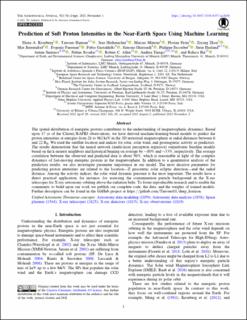| dc.contributor.author | Kronberg, Elena A. | |
| dc.contributor.author | Hannan, Tanveer | |
| dc.contributor.author | Huthmacher, Jens | |
| dc.contributor.author | Münzer, Marcus | |
| dc.contributor.author | Peste, Florian | |
| dc.contributor.author | Zhou, Ziyang | |
| dc.contributor.author | Berrendorf, Max | |
| dc.contributor.author | Faerman, Evgeniy | |
| dc.contributor.author | Gastaldello, Fabio | |
| dc.contributor.author | Ghizzardi, Simona | |
| dc.contributor.author | Escoubet, Philippe | |
| dc.contributor.author | Haaland, Stein | |
| dc.contributor.author | Smirnov, Artem | |
| dc.contributor.author | Sivadas, Nithin | |
| dc.contributor.author | Allen, Robert C. | |
| dc.contributor.author | Tiengo, Andrea | |
| dc.contributor.author | Ilie, Raluca | |
| dc.date.accessioned | 2022-01-26T13:46:29Z | |
| dc.date.available | 2022-01-26T13:46:29Z | |
| dc.date.created | 2021-11-07T12:15:13Z | |
| dc.date.issued | 2021 | |
| dc.identifier.issn | 0004-637X | |
| dc.identifier.uri | https://hdl.handle.net/11250/2839495 | |
| dc.description.abstract | The spatial distribution of energetic protons contributes to the understanding of magnetospheric dynamics. Based upon 17 yr of the Cluster/RAPID observations, we have derived machine-learning-based models to predict the proton intensities at energies from 28 to 962 keV in the 3D terrestrial magnetosphere at radial distances between 6 and 22 RE. We used the satellite location and indices for solar, solar wind, and geomagnetic activity as predictors. The results demonstrate that the neural network (multi-layer perceptron regressor) outperforms baseline models based on the k-nearest neighbors and historical binning on average by ∼80% and ∼33%, respectively. The average correlation between the observed and predicted data is about 56%, which is reasonable in light of the complex dynamics of fast-moving energetic protons in the magnetosphere. In addition to a quantitative analysis of the prediction results, we also investigate parameter importance in our model. The most decisive parameters for predicting proton intensities are related to the location—Z geocentric solar ecliptic direction—and the radial distance. Among the activity indices, the solar wind dynamic pressure is the most important. The results have a direct practical application, for instance, for assessing the contamination particle background in the X-ray telescopes for X-ray astronomy orbiting above the radiation belts. To foster reproducible research and to enable the community to build upon our work we publish our complete code, the data, and the weights of trained models. Further description can be found in the GitHub project at https://github.com/Tanveer81/deep_horizon. | en_US |
| dc.language.iso | eng | en_US |
| dc.publisher | IOP Publishing | en_US |
| dc.rights | Navngivelse 4.0 Internasjonal | * |
| dc.rights.uri | http://creativecommons.org/licenses/by/4.0/deed.no | * |
| dc.title | Prediction of Soft Proton Intensities in the Near-Earth Space Using Machine Learning | en_US |
| dc.type | Journal article | en_US |
| dc.type | Peer reviewed | en_US |
| dc.description.version | publishedVersion | en_US |
| dc.rights.holder | Copyright 2021. The Author(s) | en_US |
| dc.source.articlenumber | 76 | en_US |
| cristin.ispublished | true | |
| cristin.fulltext | original | |
| cristin.qualitycode | 2 | |
| dc.identifier.doi | 10.3847/1538-4357/ac1b30 | |
| dc.identifier.cristin | 1952063 | |
| dc.source.journal | The Astrophysical Journal (ApJ) | en_US |
| dc.relation.project | Norges forskningsråd: 223252 | en_US |
| dc.identifier.citation | The Astrophysical Journal. 2021, 921 (1), 76. | en_US |
| dc.source.volume | 921 | en_US |
| dc.source.issue | 1 | en_US |

